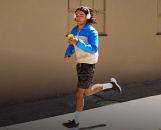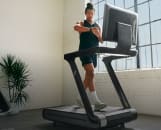
jakubzak / iStock / Getty Images Plus via Getty Images
Does Carb Loading Work, and How Do You Actually Do It?
Registered dietitians set the record straight on this pre-race nutrition strategy.
By Brigitt Earley, Kathleen Felton•
What Is Carb Loading?
Who Is Carb Loading Right For?
Does Carb Loading Work?
How to Carb Load
When to Start Carb Loading
Types of Carbohydrates to Prioritize While Carb Loading
Foods to Consider Limiting While Carb Loading
Does Meal Timing Matter While Carb Loading?
Common Carb-Loading Mistakes
The Takeaway
There are many things we do to get ready for a workout, from filling up our water bottles to prioritizing a proper warm-up. But when you really kick things into high gear—like running a marathon or tackling a triathlon, for example—your body needs even more prep to push itself further and harder. Enter a practice called carb loading.
Chances are good you’ve heard of carb loading before, but is it as simple as eating a bowl of pasta the night before a big fitness event? What’s the purpose behind this strategy, and does carb loading work? We spoke with registered dietitians to learn more about carbo loading, including who it’s right for and how to practice it in a healthy, beneficial way.
What Is Carb Loading?
“Carb loading is a performance nutrition strategy where you eat more carbohydrates leading up to exercise or an event, with the goal of enhancing your performance,” says Lexi Moriarty, RDN, a registered dietitian and certified specialist in sports dietetics at Fueled + Balanced Nutrition. “This helps to maximize the amount of glycogen, or stored energy, in the muscles and liver that's available for use during exercise.”
The goal? By increasing those glycogen stores in your muscles and liver, you might benefit from greater athletic endurance and postpone fatigue, explains Lena Bakovic, RDN, a registered dietitian nutritionist at Top Nutrition Coaching. To reap the benefits, “endurance athletes may deliberately boost their carbohydrate intake in the days leading up to an endurance competition or event,” she says.
When carb loading, athletes generally begin to increase their carbohydrate intake anywhere between 1 and 3 days prior to a race or event, adds Michelle Routhenstein, RD, a registered dietitian and owner of Entirely Nourished.
Who Is Carb Loading Right For?
Carb loading can deliver impressive benefits (more on that below), but this isn’t something you need to practice before a standard workout. “Carbohydrate loading is most beneficial for endurance athletes who are competing for more than 90 minutes of time,” Routhenstein says.
When you’re engaging in extended, high-intensity efforts, you’re more likely to benefit from those preserved glycogen stores, Bakovic explains. As a result, carb loading makes sense primarily for endurance athletes who are participating in extremely challenging physical events, such as:
Long-distance running (such as half or full marathons)
Long-distance cycling
Long-distance swimming
Triathlons
As for when you don’t need to try carb loading? Though the benefits may sound compelling for anyone trying to meet a fitness goal, it’s not necessary to do before regular workouts—say, a Pilates class or standard 30-minute jog. And when in doubt, check in with your doctor or registered dietitian to make sure carb loading makes sense for you.

Catherine Falls Commercial / Moment via Getty Images
Does Carb Loading Work?
Carb loading can absolutely help endurance athletes prepare for race day or another fitness competition by boosting glycogen stores, which could translate to improved performance and recovery. Of course, there are many factors—health, weather, course conditions, you name it—that can affect your overall results on race day, so while carb loading offers many advantages, it won’t 100-percent guarantee an excellent performance.
With that in mind, here are a few ways carb loading may benefit you.
It May Improve Race Times
When it comes to regular exercise—like a barre or cycling, or even a running a 5K race—the amount of glycogen you have stored in your body should be enough to power you through. But when exercise exceeds 90 minutes and is particularly strenuous, your body may require extra fuel, which comes in the form of glycogen.
“Carb loading will not necessarily make you faster, but it will allow you to maintain your pace longer without fatiguing due to the larger amount of glycogen energy available,” explains Alex Larson, RD, a registered dietitian who works with endurance athletes.
When you strategically fuel up ahead of time with carbohydrates, you give your body a boost of extra glycogen stores, potentially resulting in a performance boost. One older study suggests this kind of carb loading can provide a 2–3 percent performance increase for exercise longer than 90 minutes. In a long race, that might translate to crucial minutes off your time.
It Can Increase Stamina
Prolonged or intense exercise depletes the glycogen stores in your muscles and liver, which leads to fatigue. So the longer your glycogen stores last, the longer you may be able to maintain stamina and stave off mid-exercise fatigue. “Enhancing glycogen reserves via carb loading can help to postpone fatigue, enabling athletes to sustain higher intensity and endurance activities for more extended durations of time,” Bakovic explains.
In other words, since carb loading helps to top off glycogen stores, it may help you avoid total glycogen depletion by the end of a race or fitness competition, boosting your endurance. Speaking of which…
It Could Aid In Recovery
Carb loading tops off those glycogen stores, so you’re less likely to be totally depleted post-event. And if your body has leftover glycogen stores at the end of a race (or another endurance event), it can help make recovery more efficient, Moriarty says. Not to mention, replenishing glycogen stores is crucial for preparing the body for subsequent training sessions or competitions.
How to Carb Load
Though carb loading is relatively simple, there are a few factors that can improve your chances of practicing it correctly and, thus, reaping the most benefits.
First, You Need to Time It Right
Aim to begin carb loading 1–3 days before the event—sometimes as many as 6 or 7, especially if you’re undertaking a very long endurance race. “Generally, carb loading is most successful when implemented 3–7 days prior to the event,” Bakovic says. The longer the physical feat, the more time you probably need to spend carb loading, Larson says. (That means you likely want to start carb loading sooner in advance for an ultramarathon than, say, a half marathon.)
Next, You’ll Increase the Amount of Carbs You Eat
Generally, endurance athletes need 10–12 grams of carbohydrates per kilogram of bodyweight per day (or about 5 grams per pound). That total number of carbs should be divided across your typical meal pattern, Larson advises. So for example, if you eat three meals and three snacks per day, you’d aim to incorporate your total number of carbs across all six of those instances rather than trying to squeeze them in solely at dinnertime. Overall, somewhere between 70 and 80 percent of your daily calories will be made up of carbohydrate-dense foods when you’re carb loading, Bakovic says.
Meanwhile, You Should Be Exercising a Lot Less—If At All
“Slowly raising carb intake while reducing your training intensity is important,” Bakovic says. Decreasing training intensity helps you conserve energy, in turn facilitating glycogen replenishment, she adds.
Finally, You’ll Want to Choose Optimal Foods
When you’re carb loading, “it's best to seek out foods that are lower in fat, lower in protein, and high in carbs,” Larson suggests. For example, doughnuts may have plenty of carbs, but you’re better off choosing a bagel before competing in a big endurance event.
When to Start Carb Loading
With all of the above tips in mind, here are a few of the most common carb-loading approaches you might want to try, depending on the endurance event you’re training for.
1-Day Carb Loading
Arguably the most common type of carb loading among beginner or hobbyist athletes, the 1-day carb loading approach is undeniably simple and great for shorter, less intense forms of exercise like a half marathon or triathlon.
Here’s how it works: One day before the big event, athletes should avoid exercise and consume a carb-rich diet. In order to carb load properly on a one-day schedule, you should aim to consume about 10–12 grams of carbohydrates per kilogram of body weight, Routhenstein says. So for instance, a 150-pound person following this strategy would consume about 680 grams of carbohydrates throughout the day before their race.
3-Day Carb Loading
During a classic 3-day carb loading approach for longer distance events, athletes typically consume at least 70 percent of their standard daily calories in the form of carbohydrates while simultaneously drastically reducing physical activity. Experts, including Larson, generally recommend this approach for a full marathon or long-distance triathlon.
6-Day Carb Loading
For distance events like an Ironman, some professionals recommend carb loading for as many as 6 days prior to the race. During a 6-day program, athletes generally maintain exercise while consuming a low-carb diet (about 15 percent of their standard total calories) to decrease glycogen stores during those initial three days. (Some athletes opt for a more moderate carbohydrate consumption during these first few days—closer to 50 percent of their total calories.) Then, three days prior to the race, they boost carbohydrate consumption to as much as 70 percent of their total calories while simultaneously reducing physical activity.
All that said, in most situations, “the 6-day carb load isn’t usually necessary unless you know you won’t be able to meet your carb loading goals in the few days before your event,” Larson says.
Types of Carbohydrates to Prioritize While Carb Loading
When you’re carb loading, look for foods that are lower in fat, lower in protein, and high in carbs. “Complex and nutrient-rich carb sources will be of particular benefit,” Bakovic says. Think wholesome carbs, fruits, and vegetables like the following:
Pasta
Quinoa
White or whole-grain bread
White or brown rice
Smoothies, especially those containing bananas and citrus
Potatoes (peeled) or sweet potatoes
Carrots
Corn
Peas
Applesauce
Pretzels
Low-fiber cereals
Fruit juices

Galina Zhigalova / iStock / Getty Images Plus via Getty Images
Foods to Consider Limiting While Carb Loading
When you’re carb loading, experts recommend limiting high-fiber and high-fat foods, which might lead to gastrointestinal discomfort, including bloating and diarrhea on race day. “Steering clear of high-fat and high-fiber foods just before competition will additionally help in the prevention of gastrointestinal issues during competition,” Bakovic says.
Some foods to consider limiting while you’re carb-loading (even if they technically contain carbs!) include:
Pizza
Candy
Pastries
Creamy sauces
Doughnuts
Energy bars
Ice cream
Chips
Beans
Cookies
French fries
Oatmeal
Cruciferous vegetables
Alcohol
Caffeine
Does Meal Timing Matter While Carb Loading?
When you’re carb loading, the timing of your meals “absolutely” makes a difference, Bakovic says. In addition to avoiding those high-fat, high-fiber foods in the meals leading up to your big day, “it’s important to spread carbohydrate consumption consistently throughout the day versus just during one or two meals and snacks,” she explains. (In other words, just one big pasta dinner after a regular day of eating might not be enough.)
In the one to two days before an event, aim to have one of the carbohydrate-dense foods above every few hours at least. “Consuming carbohydrate-rich meals every three to four hours has been shown to be imperative in helping to optimize athletic performance,” Bakovic says.
If you’d feel comfortable doing so, Larson notes that using a food journal while you’re carb loading can help ensure you’re consuming plenty of carbohydrates to fuel your body in advance of the big day—and balancing your meals out. There are plenty of online tools that can help with this, but you can also go the old-fashioned route with pen and paper or use a notes app on your phone.
Related Articles

Nutrition
What Are Complex Carbohydrates and How Do They Fuel Your Workouts?

Nutrition
What to Eat the Night Before a Race, Whether You’re Running a 5K or a Marathon

Health
How to Prevent Bonking During Your Next Endurance Run or Ride

Nutrition
What to Eat for Breakfast Before a Marathon to Stay Strong Through the Finish
Common Carb-Loading Mistakes
Trying just about anything new comes with a learning curve. Fortunately, knowing some of the most common mistakes athletes make when carb loading can help you achieve success right out of the gate. Here’s what not to do.
1. Carelessly Carb Loading
The most common carb-loading mistake athletes make is simply eating a large volume of food, rather than mapping out meals and snacks that come with the (beneficial) carbs you need. When athletes focus on quantity alone, they often don’t actually eat enough carbohydrates, Larson says. So for best results, it’s not enough to simply consume carb-rich foods. Consider this: Some candy bars and pastries might contain more carbs than a serving of pasta, but the latter is the more optimal choice when prepping for a test of physical endurance.
2. Laser-Focusing on Carbs Alone
“Athletes may also make the common mistake to hyper-focus on carbohydrates during carb loading,” Routhenstein says. They might forget to consider things that can actually deter their performance goals, like not consuming enough protein or not staying adequately hydrated.
3. Introducing New Foods
Experts say it’s not advisable to introduce any new foods when you’re carb loading. Anything you’re not used to can lead to digestive issues like an upset stomach or even an allergic reaction—two things you definitely don’t want to deal with before an important fitness event. “Stick to familiar carbohydrate-rich foods,” Bakovic says.
4. Consuming Too Much Fat
Eating enough fat is crucial for fueling our bodies on a daily basis. But when you're practicing carb loading, it's possible to inadvertently consume too much fat in the process, which may lead to adverse results like gastrointestinal discomfort or impeded performance levels, Routhenstein says. For instance, experts recommend pairing your pre-race pasta with a light marinara sauce rather than a creamy alfredo to avoid any discomfort the next day.
5. Consuming Too Much Fiber
Eating too much fiber can also cause unwanted side effects like bloating, diarrhea, and general intestinal distress, Routhenstein says. Though high-fiber foods are vital parts of a healthy diet, the registered dietitians we spoke with generally recommend avoiding foods like beans and cruciferous veggies when carb-loading right before a big fitness event to avoid the risk of those not-so-fun side effects.
6. Exercising Too Much
Oftentimes, athletes will exercise too much prior to their event, which limits the extent of glycogen, or stored carbohydrates, to be in effect—even with a high-carbohydrate diet, Routhenstein says. Cutting back on your training during the carb-loading period can help your body store more of that energy-giving glycogen.
7. Saving All Carbs for Dinner
Don't jam-pack a day’s worth of carbs in at dinnertime, Larson reiterates. Otherwise, you're going to be uncomfortably full. A smarter option is to spread your carbs across meals and snacks throughout the day, aiming for intake every three or four hours.
8. Not Properly Hydrating
Staying hydrated is always important, but it’s especially crucial when you’re carb loading. The reason? Eating more carbohydrates requires more water for your body to properly absorb and digest them. “Glycogen storage requires water, so staying hydrated is essential,” Bakovic says.
The Takeaway
Carb loading is an effective way for endurance athletes to boost performance and stamina, and even speed up the recovery process—and it only takes a few days to effectively do so. Plus, the formula is simple: increase carbs and decrease exercise a few days before your event. But don’t forget to pay attention to what you’re eating. Simply focusing on consumption isn’t the path to success—choosing wholesome carbohydrates is. And make sure to treat your body to the other things it needs to perform at an optimal level; plenty of fluids and a good night’s sleep are key too.

Peloton App
Access thousands of classes with no equipment needed.
This content is for informational and educational purposes only and does not constitute individualized advice. It is not intended to replace professional medical evaluation, diagnosis, or treatment. Seek the advice of your physician for questions you may have regarding your health or a medical condition. If you are having a medical emergency, call your physician or 911 immediately.
Level up your inbox.
Subscribe for a weekly dose of fitness, plus the latest promos, launches, and events.
By providing your email address, you agree to receive marketing communications from Peloton.
For more about how we use your information, see our Privacy Policy.






